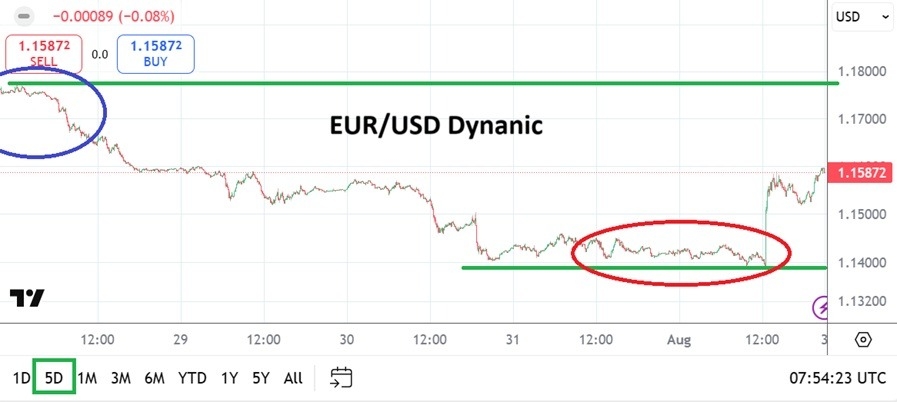- Highs of nearly 1.17700 were seen early on Monday the 28th of July, lows around the 1.13925 ratio were flirted with this past Friday, and then a buying spurt took the EUR/USD near 1.15872 going into this weekend.
- The U.S Federal Reserve as expected on Wednesday dampened hopes of an interest rate cut in September, and tariff talk from the White House may have caused some risk appetite fatigue, but then on Friday U.S jobs numbers shifted outlooks once again.
- The EUR/USD has produced rather volatile results the past handful of months, but from a mid-term perspective remains within a higher ground technically depending on perspectives.
- The weaker than expected U.S Non-Farm Employment Change data published on Friday showed weaker than expected hiring. This quickly equated into a weaker USD based on the assumption the Federal Reserve will have to now consider an interest rate cut in September, and back off their overly cautious mantra led by Fed Chairman Jerome Powell which has been preaching uncertainty.

Highs and Lows Produce a Middling Price End of Week
The highs and lows produced this week in the EUR/USD correlated to the broad Forex market. Financial institutions clearly are not feeling comfortable. Volatility and choppy conditions in Forex have been abundant. The EUR/USD is a central part of the dynamic Forex action. The ability to come within sight of 1.18000 early last week and then go below the 1.14000 level should be a clear warning sign for day traders to stay cautious and conservative in the days ahead.
Top Forex Brokers
Risk appetite has been strong in U.S equities, but indices tumbled a bit on Friday. The week ahead regarding tariff news and potential Federal Reserve implications may stir the marketplace. Forex is typically a bit quiet in August due to summer holidays, but last week’s results show the EUR/USD cannot be counted upon for serene price movement. The move higher on Friday was good, but it was not a guarantee that bullishness is about to continue into the coming days. U.S economic data and outlooks will be debated and this will cause near-term choppiness.
Timeframes and Financial Institutions Shifting Positions
The constant news flow from Washington D.C is not helping create a calm Forex landscape. In the mid-term financial institutions may still be leaning into USD weakness, but the past two weeks saw nervousness build and the EUR/USD get weaker in many cases.
- Intermittent reversals higher were met by stronger selling than many day traders anticipated.
- The notion that U.S economic data is weaker than expected will be debated by various sources who may have political bias.
- Day traders speculating on daily gyrations in the EUR/USD need to remain calm.
- This coming week will be light on big U.S economic data, which means behavioral sentiment will rule Forex depending on how the winds are blowing.
EUR/USD Weekly Outlook:
Speculative price range for EUR/USD is 1.15360 to 1.17600
Having seen a solid amount of selling since the 24th and 25th of July, the EUR/USD now needs to be looked at per the possibility it may be in oversold territory. The lows seen on Friday of this past week, before the U.S jobs numbers were published, which touched the 1.13925 vicinity will likely not be challenged again unless there is another dose of selling impetus which causes the broad markets to turn extra sour and risk appetite to evaporate.
The 1.15000 realm even looks too low. Some bullish traders may believe the 1.16000 ratio should be a natural target and the EUR/USD could traverse within the 1.16000 to 1.17000 level rather comfortably. Day traders should be cautious. The price velocity in the EUR/USD produced the past month has been significant. The 1.15900 mark will be tested early on Monday and likely provide a barometer for early sentiment, trading above this level if coupled with opinions that the U.S Fed will cut interest rates in September could help fuel more buying.
Ready to trade our weekly forecast? We’ve shortlisted the best European brokers in the industry for you
